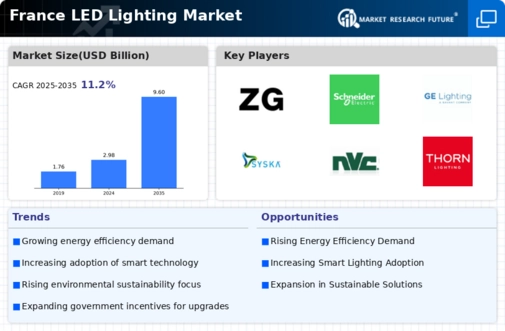Technological Advancements
Technological advancements play a crucial role in shaping the led lighting market in France. Innovations in LED technology, such as improved lumens per watt efficiency and longer lifespans, have made LED lighting increasingly attractive to consumers and businesses alike. The integration of smart technologies, including IoT capabilities, allows for enhanced control and customization of lighting systems. This trend is reflected in the growing demand for smart LED solutions, which are expected to account for a substantial share of the market by 2026. The led lighting market is thus experiencing a transformation, as manufacturers invest in research and development to create more efficient and versatile lighting products that meet the evolving needs of consumers.
Government Regulations and Incentives
The led lighting market in France is significantly influenced by government regulations aimed at promoting energy efficiency and reducing carbon emissions. The French government has implemented various policies that encourage the adoption of energy-efficient lighting solutions. For instance, financial incentives such as subsidies and tax rebates are available for businesses and households that switch to LED lighting. These initiatives not only lower the initial investment costs but also enhance the overall appeal of LED technology. As a result, the market is projected to grow at a compound annual growth rate (CAGR) of approximately 10% over the next five years, driven by these supportive measures. The led lighting market is thus positioned to benefit from a favorable regulatory environment that prioritizes sustainability and energy conservation.
Cost-Effectiveness and Long-Term Savings
The cost-effectiveness of LED lighting is a significant driver for its adoption in France. Although the initial purchase price of LED fixtures may be higher than traditional lighting options, the long-term savings on energy bills and maintenance costs make them a more economical choice. LED lights have a lifespan of up to 25,000 hours, significantly reducing the frequency of replacements. This aspect is particularly appealing to businesses looking to minimize operational expenses. As energy prices continue to rise, the financial advantages of switching to LED technology become increasingly apparent. Consequently, the led lighting market is likely to experience robust growth as more consumers and businesses recognize the potential for substantial cost savings.
Rising Awareness of Environmental Impact
There is a growing awareness among consumers and businesses in France regarding the environmental impact of traditional lighting solutions. This heightened consciousness has led to an increased demand for energy-efficient alternatives, particularly in the led lighting market. Studies indicate that LED lights consume up to 80% less energy than incandescent bulbs, which resonates with environmentally conscious consumers. Furthermore, the reduction in greenhouse gas emissions associated with LED usage aligns with France's commitment to sustainability. As a result, the led lighting market is witnessing a shift towards more eco-friendly lighting options, which is likely to drive market growth in the coming years.
Urbanization and Infrastructure Development
Urbanization and infrastructure development in France are key drivers of the led lighting market. As cities expand and modernize, there is a growing need for efficient and sustainable lighting solutions in public spaces, roadways, and commercial buildings. The French government has initiated several urban development projects that prioritize the installation of LED lighting to enhance energy efficiency and reduce operational costs. This trend is expected to continue, with investments in smart city initiatives further propelling the demand for LED technology. The led lighting market is thus poised for growth, as urban planners and developers increasingly recognize the benefits of integrating LED solutions into their projects.






















Leave a Comment